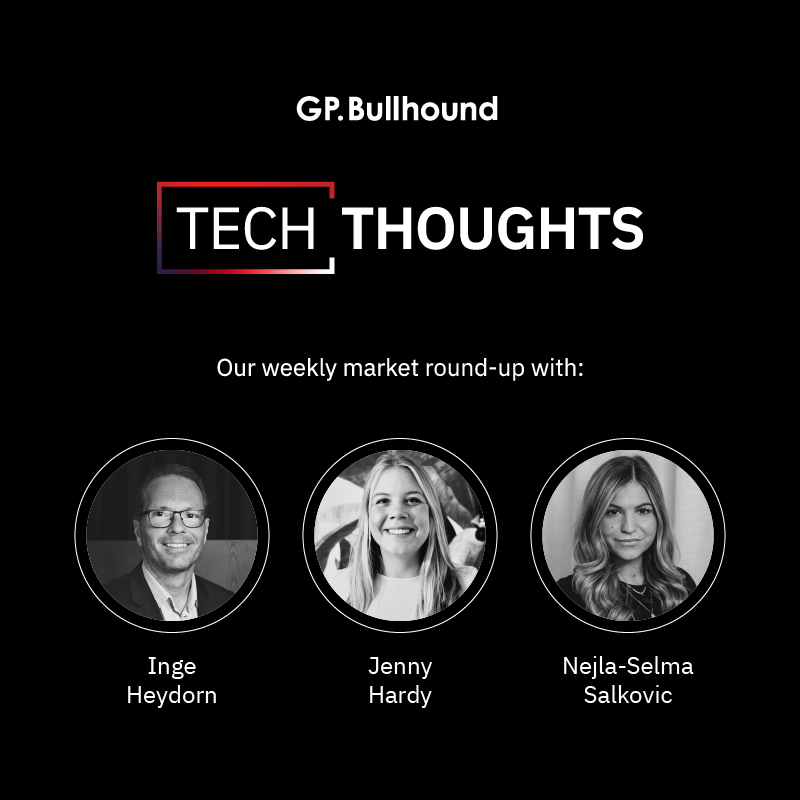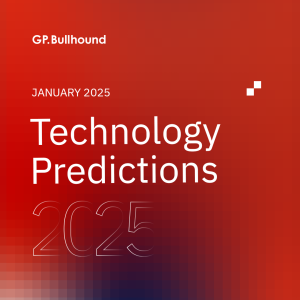Tech Thoughts Newsletter – 18 August 2023.

Market: A relatively quiet results week in tech and still low summer volumes. Global government bond yields continued to increase, in some cases returning to 2008 levels, which had a negative impact on markets and tech. China macro is in focus again this week, as PBOC lowered its one-year policy rate by 15bps, and concerns over Chinese shadow banking and its property sector persisted.
Portfolio: we made no major changes to the portfolio this week.
Semicap – DRAM spend inflecting
- Applied Materials (owned) reported a strong beat and a very strong guide.
- The beat was driven by strong DRAM spend offset by weakness in NAND, and strong trailing edge foundry/logic offset by weaker leading edge.
- DRAM revenue is guided to increase again next quarter, driven by China, but management also spoke to some of the newer AI HBM technologies that are currently being built.
- Management’s commentary that its ICAPS business (IoT, Comms, Auto, Power and Sensors – effectively trailing edge) can sustain these revenue levels (we think as much as 3x the pre-Covid levels) was a positive, which speaks to the structural shortage in supply that is being built for (TSMC and Infineon/NXP’s joint Dresden fab announcement last week focused on auto semis – that will all require more manufacturing tools).
- One thing management noted was the extent to which ICAPS markets are large vertical markets (auto, industrial) in every geography, and that having a secure supply chain is critical for everyone, meaning much of the geopolitical investment should be around more trailing-edge technologies (which we agree makes much more sense than every country trying to build their own leading-edge fab).
- One of the potential concerns of such strong results is around a pull forward of demand from China (effectively shipping more tools than they need to try to get ahead of export restrictions), but we’re reassured by AMAT’s utilisation data that shows the machines being installed and operated (and noting that local China capacity is still much less than local consumption).
- Aside from ASML, AMAT is defending revenue the best in the current market downturn, given early investment in, and over-exposure to, its trailing edge ICAPS business.
- $2.3bn cash flow in the quarter – reflects the resiliency we’ve seen across semicap reporting this quarter.
Portfolio view: Semicap equipment (we own Applied Materials, LAM Research, ASML and KLA) remains a key exposure in the portfolio for us. There are multiple growth drivers which will support revenue growth out to 2030 – technology transitions, geopolitics, AI; and their business models and strong market positions in each of their process areas allow them to sustain strong returns and cash flows even in a relative downturn.
AI lifting network requirements
- Cisco (owned) reported a slight beat (remembering that it had consistently raised guidance throughout the year). Gross margins stood out, with positive pricing, product mix and easing logistics costs all contributing.
- A better supply environment helped, and its software business showed strong growth. Guidance was slightly light – calling for flat/small growth after this year’s 11% growth, as we transition back to a more normal supply environment. Nevertheless, flat to small growth after double-digit growth this year, underpinned by $24bn ARR for renewal still makes Cisco quite different from the turns business it used to be.
- The company has been carrying excess backlog, given supply constraints and strong demand, and ended FY23 (June year-end) with twice the normal backlog. As lead times begin to come down, that will clear and lead to less lumpy growth.
- The big debate this year has been the extent to which Nvidia’s Infiniband (which it acquired as part of Mellanox) will become the de facto industry standard for AI workloads or whether ethernet (which Cisco sells) will start to be adopted for AI. The back end is important because that’s still where a lot of the performance/power equation rests – more compute requires more network bandwidth and switching intensity and, again, more demand for their products – GPU clusters which used to run AI chats need about 3x more bandwidth than a traditional compute network today. Arista and Cisco are clearly pushing ethernet and related tech, Nvidia pushing Infiniband. A Cisco representative commented:
In the last call, we talked about the fact that this would probably be three to four times the opportunity size of the original cloud build-out. And, unfortunately for us, as it’s been well documented, we missed the original cloud build-out. But I can say with every bit of confidence right now that as we go through this AI transition to Ethernet, we are super well positioned.”
- Positively, Cisco noted they had taken orders for over $0.5bn for AI Ethernet (underneath AI GPU networks), and were piloting 800gig capabilities for AI training fabrics.
Portfolio view: We own Cisco and Arista and see AI increasing networking requirements in the back end. In almost the same way that we expect hyperscalers to not want to be tied entirely into Nvidia chips, we expect that they will also want an alternative to Infiniband and therefore expect ethernet to start to be adopted for some AI workloads, which will benefit both Cisco and Arista.
Governments building AI capacity
- The FT reported this week that Saudi Arabia and the UAE were buying up Nvidia chips. Saudi Arabia has supposedly bought at least 3000 H100 chips, which would be close to $120m investment.
- The Saudi LLM is being developed by Provable Responsible AI, which the FT notes is staffed by Chinese researchers.
- We’re clearly still waiting on whether the US government decides to bring in more restrictions on US chips into China but it’s not hard to imagine AI and geopolitics are becoming increasingly intertwined.
Portfolio view: An AI arms race at a government (as well as a big tech) level is clearly good news for Nvidia (which we believe is supply-constrained) and AMD
PC end market weakness, EV and AI servers are the bright spots
- Hon Hai reported Q2 results which beat consensus but the bigger news was the company revising its full-year sales growth target for 2023 from flat to slightly down yr/yr, mainly on networking/general servers and PC weakness. It’s no real surprise given what we’ve heard elsewhere. AI servers and EV were the bright spots estimating AI server revenue grew more than 200% in H1.
- Quanta’s Q3 guidance was for Q3 notebook shipments to be flat to slightly down qtr/qtr, but its AI servers business outlook too was very strong – it raised server sales growth guidance from single digit yr/yr to double-digit yr/yr on AI server demand, with all of its H2 server projects AI related.
- PC ODM results for July generally came in below usual seasonality (after a strong pull in demand in June) and, generally, players remain quite cautious around PC demand in H2 (though recognising that inventory is at much healthier levels).
Portfolio view: We don’t own any ODMs and we try to limit any direct PC market exposure (we don’t own Intel, and while AMD will be impacted, we believe AI server demand will more than offset). While the inventory corrections seem to be largely behind us in the PC space, there is still no visible demand recovery.
China smartphone market still weak
- Will Semi, which is particularly exposed to the Chinese smartphone market, was weak as expected, still showing strong inventory clearance impacts, and still reporting inventory levels much higher than where they should be.
- SMIC spoke to a similar scenario with “overall demand not showing a strong rebound…” though did speak to inventory in some products beginning to decline.
- IDC reported Q2 smartphone shipments down 7% yr/yr and, generally, market commentary has been for a muted demand recovery in H2. At the moment we expect 2023 smartphone shipments to decline mid to high single digits in 2023, after ~-10% in 2022. With a low base, it’s hard not to call some sort of eventual recovery in 2024, though the shape of that remains uncertain.
Portfolio view: We still try to limit any direct exposure to the smartphone market, where the outlook seems to have deteriorated further over the last several months and where components get commoditised (and lose pricing power, becoming extremely volume dependent) very quickly.
Tesla price cuts… again
- Tesla cut its prices in China again, reducing the price of its Model Ys by ~$1,900.
- That was followed by adding two lower-spec versions of its Model S and X in the US and Canada and reducing the price by as much as $10,000. By our count, that’s the 7th price cut in the US so far this year.
Portfolio view: Price wars in EV is clearly bad news for the auto OEMs (which we don’t own) but good news for the auto semis (who still have pricing power). We own NXP and Infineon which both benefit from the shift to EV.

For weekly insights on the latest market updates, please subscribe to our Tech Thoughts podcast.
For more information about the latest trends and forecasts, please visit our official Tech Thoughts page.
We provide investors with access to category-leading technology companies, globally. Our assets under management have a total value of more than $1bn, and our limited partners include institutions, family offices and entrepreneurs. Learn more about our funds here.
Enquiries
For enquiries, please contact:
Inge Heydorn, Partner, at inge.heydorn@gpbullhound.com
Jenny Hardy, Portfolio Manager, at jenny.hardy@gpbullhound.com
Nejla-Selma Salkovic, Analyst, at nejla-selma.salkovic@gpbullhound.com
About GP Bullhound
GP Bullhound is a leading technology advisory and investment firm, providing transaction advice and capital to the world’s best entrepreneurs and founders. Founded in 1999 in London and Menlo Park, the firm today has 14 offices spanning Europe, the US and Asia.



